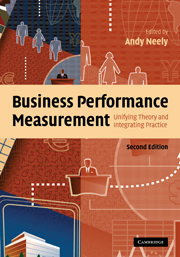Book contents
- Frontmatter
- Contents
- List of figures
- List of tables
- List of boxes
- List of contributors
- Introduction
- Part I Performance measurement – functional analyses and theoretical foundations
- Part II Performance measurement – frameworks and methodologies
- Part III Performance measurement – practicalities and challenges
- Part IV Performance measurement in public services
- Part V Performance measurement – emerging issues and enduring questions
- 20 Does pay for performance really motivate employees?
- 21 Anomalies of measurement: when it works, but should not
- 22 Loosely coupled performance measurement systems
- Index
- References
20 - Does pay for performance really motivate employees?
Published online by Cambridge University Press: 22 September 2009
- Frontmatter
- Contents
- List of figures
- List of tables
- List of boxes
- List of contributors
- Introduction
- Part I Performance measurement – functional analyses and theoretical foundations
- Part II Performance measurement – frameworks and methodologies
- Part III Performance measurement – practicalities and challenges
- Part IV Performance measurement in public services
- Part V Performance measurement – emerging issues and enduring questions
- 20 Does pay for performance really motivate employees?
- 21 Anomalies of measurement: when it works, but should not
- 22 Loosely coupled performance measurement systems
- Index
- References
Summary
Introduction
Variable pay for performance may undermine employees' efforts, as rewards crowd out intrinsic motivation under identified conditions. A bonus system then makes employees lose interest in the immediate goal. Moreover, monetary incentives in complex and novel tasks tend to produce stereotyped repetition, and measurement is often dysfunctional. Therefore, intrinsic motivation is crucial for these tasks. However, for some work extrinsic incentives are sufficient. We offer a framework for how managers can achieve the right balance between intrinsic and extrinsic motivation.
Variable pay for performance and motivation
Variable pay for performance has become a fashionable proposal over the last few years, in private companies as well as in the public sector. Many firms have given up fixed salaries and have moved to pay their employees in a variable way. Firms try to match payment to objectively evaluated performance. It is reflected in such popular concepts as stock options for managers and various types of bonuses. In the public sector, efforts to raise productivity in the wake of new public management have also resulted in attempts to adjust variably the compensation of public employees for their performance. This means that firms and public administrations increasingly rely on price incentives – i.e. on extrinsic motivations.
We argue in this chapter that variable pay for performance under certain conditions has severe limitations. In situations of incomplete contracts – and these dominate work relationships – an incentive system based only on monetary compensation for work is insufficient to bring forth the performance required.
- Type
- Chapter
- Information
- Business Performance MeasurementUnifying Theory and Integrating Practice, pp. 433 - 448Publisher: Cambridge University PressPrint publication year: 2007
References
- 6
- Cited by



